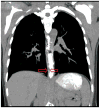Clinical implications and pathogenesis of esophageal remodeling in eosinophilic esophagitis
- PMID: 24813517
- PMCID: PMC4127387
- DOI: 10.1016/j.gtc.2014.02.015
Clinical implications and pathogenesis of esophageal remodeling in eosinophilic esophagitis
Abstract
In eosinophilic esophagitis (EoE), remodeling changes are manifest histologically in the epithelium and subepithelium where lamina propria fibrosis, expansion of the muscularis propria, and increased vascularity occur. The clinical symptoms and complications of EoE are largely consequences of esophageal remodeling. Available therapies have demonstrated variable ability to reverse existing remodeling changes of the esophagus. Systemic therapies have the potential of addressing subepithelial remodeling. Esophageal dilation remains a useful, adjunctive therapeutic maneuver in symptomatic adults with esophageal stricture. As novel treatments emerge, it is essential that therapeutic end points account for the fundamental contributions of esophageal remodeling to overall disease activity.
Keywords: Dysphagia; Endoscopy; Eosinophilic esophagitis; Esophagitis; Fibrosis; Gastroesophageal reflux disease; Remodeling.
Copyright © 2014 Elsevier Inc. All rights reserved.
Figures







References
-
- Liacouras CA, et al. Eosinophilic esophagitis: updated consensus recommendations for children and adults. J Allergy Clin Immunol. 2011;128(1):3–20 e6. quiz 21–2. - PubMed
-
- Schoepfer AM, et al. Delay in Diagnosis of Eosinophilic Esophagitis Increases Risk for Stricture Formation, in a Time-Dependent Manner. Gastroenterology. 2013 - PubMed
-
- Dellon ES, et al. ACG clinical guideline: Evidenced based approach to the diagnosis and management of esophageal eosinophilia and eosinophilic esophagitis (EoE) Am J Gastroenterol. 2013;108(5):679–92. quiz 693. - PubMed
Publication types
MeSH terms
Grants and funding
LinkOut - more resources
Full Text Sources
Other Literature Sources
Medical
Research Materials

